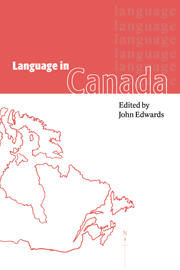Book contents
- Frontmatter
- Contents
- List of figures
- List of maps
- List of tables
- Notes on contributors
- 1 Canada
- Introduction
- 1 The foundations
- 2 The fading Canadian duality
- 3 Official bilingualism: from the 1960s to the 1990s
- 4 Official multiculturalism
- 5 Language in education: bridging educational policy and social psychological research
- 6 Aboriginal languages: history
- 7 Aboriginal languages: current status
- 8 French: Canadian varieties
- 9 French in Quebec
- 10 French in New Brunswick
- 11 French outside New Brunswick and Quebec
- 12 English: Canadian varieties
- 13 English Quebec
- 14 The teaching of international languages
- 15 French immersion in Canada
- 16 Language in Newfoundland
- 17 Language in Prince Edward Island
- 18 Language in Nova Scotia
- 19 Language in New Brunswick
- 20 Language in Quebec: aboriginal and heritage varieties
- 21 Language in Ontario
- 22 Language in Manitoba
- 23 Language in Saskatchewan: Anglo-hegemony maintained
- 24 Language in Alberta: unilingualism in practice
- 25 Language in British Columbia
- 26 Language in the Northwest Territories and the Yukon Territory
- Index of names
- Index of language families, languages, dialects
- Index of subjects
2 - The fading Canadian duality
Published online by Cambridge University Press: 18 February 2010
- Frontmatter
- Contents
- List of figures
- List of maps
- List of tables
- Notes on contributors
- 1 Canada
- Introduction
- 1 The foundations
- 2 The fading Canadian duality
- 3 Official bilingualism: from the 1960s to the 1990s
- 4 Official multiculturalism
- 5 Language in education: bridging educational policy and social psychological research
- 6 Aboriginal languages: history
- 7 Aboriginal languages: current status
- 8 French: Canadian varieties
- 9 French in Quebec
- 10 French in New Brunswick
- 11 French outside New Brunswick and Quebec
- 12 English: Canadian varieties
- 13 English Quebec
- 14 The teaching of international languages
- 15 French immersion in Canada
- 16 Language in Newfoundland
- 17 Language in Prince Edward Island
- 18 Language in Nova Scotia
- 19 Language in New Brunswick
- 20 Language in Quebec: aboriginal and heritage varieties
- 21 Language in Ontario
- 22 Language in Manitoba
- 23 Language in Saskatchewan: Anglo-hegemony maintained
- 24 Language in Alberta: unilingualism in practice
- 25 Language in British Columbia
- 26 Language in the Northwest Territories and the Yukon Territory
- Index of names
- Index of language families, languages, dialects
- Index of subjects
Summary
Census data are by far the best source of statistical information on language in Canada. Surveys have occasionally investigated language behaviour in greater depth, but their results inevitably suffer from limited sample size and lack of comparability. Though the earliest censuses recorded only the ethnic origins of Canadians, reasonably consistent data on mother tongue and ability to speak English or French were also collected by 1931. A question on current home language has been included since 1971, following the dissatisfaction of the Royal Commission on Bilingualism and Biculturalism at having to deal with mothertongue data alone: ‘the mother tongue of the individual does not tell us which language he commonly uses. The information is a generation behind the facts’ (RCBB, 1967, p. 18). Finally, the 1991 census added a question on ability to speak languages other than English or French. Thus, census data not only allow us to follow trends, but also provide a fair overview of Canada's present linguistic make-up.
ORIGIN TRENDS
Canada has been the scene of demographic competition between English and French since conquest by the British in 1759–1760. Though Canadians of British origin soon outnumbered those of French origin, high French-Canadian fertility subsequently offset the effect of international immigration and, from the mid nineteenth century up until the mid twentieth, succeeded in maintaining the French portion of the total population at about 30 per cent.
- Type
- Chapter
- Information
- Language in Canada , pp. 36 - 60Publisher: Cambridge University PressPrint publication year: 1998
- 8
- Cited by

